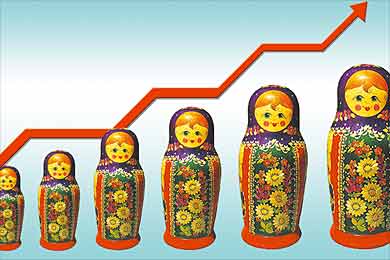The Economic Commission for Latin America and the Caribbean (Cepal)
predicted an impressing growth rate of 18% at the close of this year, and
estimated 5% growth for 2005.

The impressing increase in the Gross Domestic Product (PIB) for this year is
partly due to the fact that it is being compared to the growth figures of
2003, that reflected the effects of the strike and lock-out launched by the
opponents of the government, an action that caused a 7.6% drop, following
the 8.9% contraction in 2002.
Cepal’s estimates for 2004 are the highest by any institution so far,
including those figures suggested by high rank officials of the Central Bank
of Venezuela (BCV).
But Cepal has also predicted a higher unemployment rate, of almost 16% at
the close of 2004, followed by Argentina with almost 14%, and Uruguay and
Brazil with 12%.
The economy had a sharp 15.8% growth in the third quarter of 2004, compared
to the same period in the previous year. According to BCV estimates, the
recovery in the first 9 months of 2004 reached a solid 20.4%.
The evolution of the economic activity in the third quarter was basically
determined by non-oil related activities, which grew 18.6% of their added
value, while the oil-related activities grew 2.7%.
Venezuela has benefited this year with the high oil prices that have helped
increase the public treasury. Some officials estimate that by the end of
2004, the additional income for oil exports will be between 5,000 and 7,000
million U$.
Hugo Chávez’ bolivarian government claims that these funds are being used in
social spending for the most depressed sectors of the population.
Nevertheless, government critics of the Venezuelan process of changes claim
that these resources are being squandered (perhaps because they are being
invested for the benefit of the great majorities that had been excluded so
far) and that such spending does not eradicate the causes of poverty.
Obviously, destitution and social exclusion are structural problems that do
not have short-term solutions.

Some analysts consider that a wide expansion of public spending may trigger
inflation, that will close this year at 20%, a lower figure than that
estimated in the national budget.
Amid this context, overall demand increased 22.5%in the third quarter,
mostly due to greater private consumer spending (16.4%), to government
spending (20.9%), to fixed gross investment (46.5%), and to exports (2%).
They are almost all growing
Cepal estimated that in 2004, Latin America would have its highest growth
rate since 1980, and that it would surpass the most optimistic expectations,
with a 5.5% growth, amid the recovery of most countries in the region.
However, expectations are that this good streak will slow its pace with a 4%
growth.
"The international scenario for 2005, although still positive, seems to be
less favorable than this year’s, with a worldwide growth of 3%", said a
report by Cepal, which added that a probable deceleration of the United
States economy and the recessive and inflationary effects of high oil prices
are the main elements behind the expected scenario.
This organization estimated that the economies of China, Japan, and the euro
region would slow down somewhat.
"The risks faced by the world economy are linked to a disruption of the
equilibrium in the U.S. economy and its possible effect on the interest
rates and on the value of the dollar; to the possibility of a sudden halt in
the Chinese economy, to the uncertainties over the oil market, and to the
possible adoption of protectionist measures, especially in the US", said the
report.
Amid this scenario, the greatest regional economies, Brazil and Mexico,
would grow 4.0% and 3.6% respectively next year. According to the
international organization, the countries with the greatest expansion in
2005 would be Chile and Uruguay, with 6%, and the most sluggish would be
Colombia, with 3%, and Ecuador and Paraguay with 3.5%.
Published in Quantum N.45
 Articles by this author
Articles by this author











Stay In Touch
Follow us on social networks
Subscribe to weekly newsletter